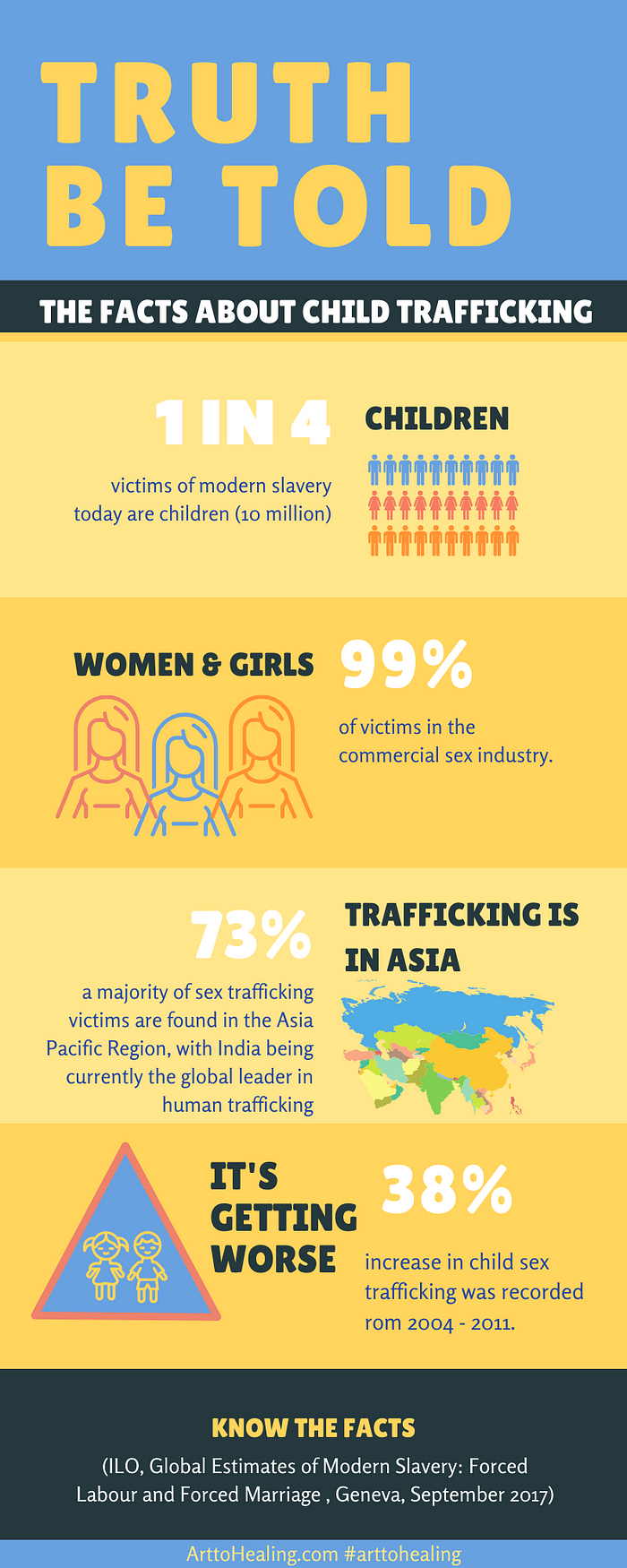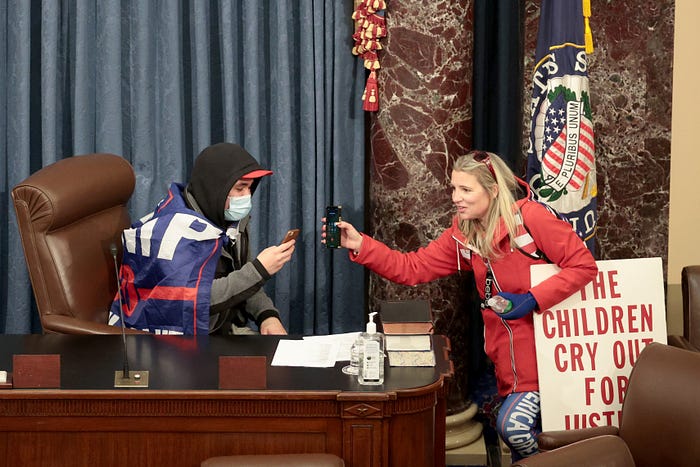#Qhurtschildren: The dangers of Con-spirituality and how to take REAL action against child sex trafficking.

Humanity is experiencing trauma on an unprecedented global level.
In many countries, people feeling trapped in lockdown have been leaning on social media for connection and community. During this vulnerable time, we are witnessing a rise in conspiracies on social media, and more frequently in people whom we have placed our trust: our political leaders, spiritual teachers, and within our communities.
Cleverly termed “Con-spirituality,” this term aptly describes the merger of conspiracy: often thinly veiled QAnon theories, and spiritual practices, such as the New Age movement, yoga, and shamanism. How QAnon, born from the underworld of right-wing racist chat rooms and anarchist minded game developers (Gurman, 2018), could somehow lure this “awakened” community is something to deeply consider.
Humans naturally quest to know “the truth.” However, the con-spirituality movement, while claiming to uncover the “truths” of our modern-day, has muddied public trust and sowed doubt in journalism and scientific data-driven policies that we need to combat real-world problems such as climate change and COVID-19.
This lack of clarity is disconnecting seekers from the actual facts. This misinformation tends to claim one thing, but in effect does the opposite: cause more harm than good.
One such example is the pervasive QAnon hashtag #savethechildren, a concept that purports to support the anti-trafficking movement, but in fact, distorts the real issues of sex trafficking.
Around June 2020, online rumors started circulating about complex and unsubstantiated schemes involving child sex trafficking. These rumors hijacked the #SaveTheChildren hashtag, which first began as a legitimate fund-raising campaign for the Save the Children charity. Packaging this emotionally potent hashtag, the truths of the severity of trafficking have been obscured, to the detriment of all.
The result of this has created a victimless discourse created by white privilege, silencing and overshadowing the voices of the marginalized survivors who, even in the best of times, have barely a fighting shot at being heard.
This metamorphosis from charity to charlatan is responsible for too much confusion, and in my opinion, has done more harm than help for those affected by sex trafficking, and those who work tirelessly to fight the issue of child sex slavery.
I am one of those souls. I know, first-hand, about the horrific practices of child sex trafficking, and I am concerned at the distortion of this issue. It’s time to speak out and re-direct those who care about stopping child sex trafficking towards making a difference that is helpful and respectful of the millions of child sex trafficked victims out there who are voiceless.
My name is Atira Tan, and I advocate for those survivors so that their voices can be heard.
I am the founder and co-director of Art to Healing, an Australian charity supporting the trauma recovery of survivors of sex trafficking, slavery, and exploitation in Asia. For the past 17 years, I have worked as a trauma specialist, an educator, and an activist, directly supporting children and women who have been sold into child sex trafficking.
My work isn’t abstract. It’s one-on-one sessions with the survivors of the sexploitation that silently exists internationally today. I have heard firsthand the stories of more than a thousand child sex slaves.
The youngest girl I’ve met who was sold into slavery was less than 2 years old at the time. She was sold into a child pornography ring in Phnom Penh. And NO amount of sharing hashtags can combat the severity of this problem.
My hope is that those who care or claim to care can shift their perspective from being caught up in the #Savethechildren hashtag into real and practical solutions. Solutions that are within reach of even those stuck at home, alone, and wondering how to help.
The Truth be Told
The statistics of the global present-day modern slavery and sex trafficking are not for the faint of heart. Slavery is often discussed as a thing of the past, but nothing is further from the truth:
- There were an estimated 40.3 million people in slavery in 2016;
- In 2016, there were 4.8 million people in the world in forced sexual exploitation;
- There are currently more than 1 million children who are victims of child sexual exploitation.

(ILO & Walk Free Foundation, 2017)
The sudden rise of “awareness” of this problem is not what it seems. Contrary to what QAnon would have us believe, sex trafficking is nothing new. And it’s on a dramatic and terrifying rise in the 21st century.
In India, where there is a long history of prostitution and sex trafficking, more than 2 million women and children are trafficked for sex into the red-light districts (Sarkar, 2014). This doesn’t involve kidnapping children. There are traditions dating back to the 7th century, where parents sell or mortgage their own daughters (Anthony, 2016).
The first recorded movement against sex trafficking was launched in England by Josephine Butler in 1869 (Ford, 2007). 152 years later we are watching as these important movements become blurred and weaponized to smear political opponents and rally the masses to drastic actions, such as the US Capitol Insurrection on January 6th, where #SaveTheChildren signs could be seen along with many infamous slogans of QAnon.

Sex trafficking is also more financially intertwined than you will ever comprehend. Human slavery is a USD$150 billion dollars per annum industry, third after weapons and pharmaceuticals. We don’t have to look far to know a little of these horrors from the ongoing saga of Jeffrey Epstein and his entourage of wealthy and powerful men and underage girls. However, it is not only happening with famous people in business, entertainment, and politics. Trafficking happens in your communities. Right under your nose. In every country. It’s connected to the rich and powerful, and it’s also connected to the poor and powerless who run trafficking rings all over the world.
Do I have your attention? Good.
If you feel drawn to connect with real stories of sex-trafficked survivors, visit the Art of Healing website or read the chapter Surviving Shame in Art Therapy in Asia (Tan, 2012).
These are real, firsthand stories and works of art from survivors about their journey into — and out of — sex trafficking. These stories were documented in an art therapy research program in Cambodia in 2006. And so many more untold stories. There is much work to do.
In contrast to the billions of dollars in profits extracted from human slavery, there are many underfunded anti-trafficking organizations that rely on the dedication of countless individuals and groups who work fearlessly on the ground, to combat trafficking.
Until recently, I worked as an unpaid volunteer for 16 years. All of our staff are volunteers. I know of countless colleagues who fight tirelessly, dedicating their efforts to stop sex trafficking out of pure passion and dedication. We’re not altruistic souls choosing to be poor and overworked. Our work requires us to be as funding is competitive and difficult to obtain, but our passion for social justice and equality overrides the financial challenges we face.
Sunita Krishna is an Indian social activist and co-founder of Prajwala, an NGO that rescues, rehabilitates, and integrates sex-trafficked victims.
By the age of twelve, Sunita was running schools in slums for underprivileged children, and at fifteen years old — while helping at a neo-literacy campaign for the untouchable caste in India — Sunita was physically and sexually attacked for interfering with a “man’s society”. Despite becoming partially deaf from this attack, Sunita is dedicated to end child sex slavery. And she has had a tangible impact: to date, Prajwala and Sunita’s efforts have rescued and rehabilitated over 12,000 survivors of sex trafficking. The scale of their operations makes them the largest anti-trafficking shelter in the world.
One person can make a phenomenal difference to thousands. But compared to the 40 million+ people currently estimated to be held in slavery, this work is a drop in the bucket. We need your help if we are truly going to save the children.
Another woman that I feel privileged to have supported and with whom Art to Healing have partnered, is Charimaya Tamang, the current director of the anti-trafficking organization, Shakti Samuha.
Shakti Samuha, co-founded in 2000 by Charimaya and a group of survivors, is the world’s first organization established and run by the survivors of human trafficking. The organization runs five shelter homes for trafficking survivors and has provided educational support to more than 1500 children. Over 1000 trafficking survivors have received shelter support from Shakti Samuha, a necessary step to break the cycle of trafficking.
While these are clearly some of the most laudable leaders in this important work, this is what taking action looks like. Their efforts have real-world results. Leaders like Sunita and Charimaya work tirelessly for their cause. And it is this type of work that causes real-world change.
And you can help.
Let’s get Clear
Prajwala, Art to Healing, and Shakti Samuha make up a tiny fraction of the many anti-trafficking organizations around the world focusing on practical solutions, reducing and preventing sex trafficking, helping survivors to heal, and reducing the root causes of trafficking: poverty, addiction, lack of education and gender discrimination.
Our work is based on qualitative and quantitative research, monitoring and evaluating standards, and policies that affect global anti-trafficking strategies. The provision of effective assistance to victims/survivors of human trafficking requires the ongoing collaboration of different sectors, such as health and social services, law enforcement, immigration, and other government agencies, and intergovernmental organizations. This involves knowledge and experience in the field, and years of listening to the voices of survivors so that we can understand how to help.
Effective action is practical, intelligent, and consists of innovative solutions based on experience and expertise. Action is recognizing the leaders in this field and funding them, supporting them, spreading the word, and aiding those who lead the charge against these atrocities. “Taking action” is NOT sharing a #savethechildren post on your Instagram story. However, truly effective action can create change in this $150 billion dollar industry.
The same powerful interests involved in the sex trade are also involved in funding and supporting nefarious groups utilizing the vulnerability of our collective trauma to sow discord and prevent legitimate help from reaching those who need it. The recently-outed child-pornography-hosting founder of QAnon has rallied the masses under false pretenses of child sex trafficking while actually being involved in the trade itself. By now we must see that QAnon’s trajectory — and by association, those that follow — has little to do with reducing human trafficking, and instead, creates fear, doubt, confusion, and separation from the all-too-real issues at hand, wasting the precious resources of a knowledgeable public.
The evidence behind the claims of the hijacked #SaveTheChildren hashtag is not just insubstantial but intentionally spreads misinformation, pointing well-meaning people in the wrong direction, distracting and diverting attention and funding away from the millions of sex-trafficked children around the world that were already critically under-supported without this new confusion.
There are countless individuals and respected organizations dedicated to the efforts of ending the cycle of sex slavery, trafficking, and exploitation. There are ways that you can help and support them rather than sharing misleading information and potentially causing greater harm.
Belief is a powerful tool; factual knowledge and informed action is an even more powerful one. Only the latter will help the millions in need today.
3 ways you can take stop harming and start helping the issue of child sex trafficking:
1: STOP posting on social media and spreading insubstantial claims of sex trafficking. Stop promoting and spreading misinformation and conspiracies involving famous people in politics and media without evidence from the police and local authorities. You are diverting valuable resources from legitimate groups who are actually trying to stop trafficking.
Instead, start by donating. It’s one of the easiest ways you can contribute. If you find a person in your community who is working to combat trafficking, support them. Help us expand our efforts and continue to fight the fight by directing resources to us.
Need help identifying real organizations from the fake? Look for survivor-led, grassroots organizations. Start local. They tend to be underfunded, and need your help to continue their efforts. If you want to work on a local level, you can find anti-trafficking organizations within your community and set up a monthly donation plan with them. Organizations such as the Dreamcatcher Foundation in Chicago, USA, and the aforementioned Shakti Samuha in Kathmandu, Nepal, are both survivor founded, survivor driven, and survivor focused agencies fighting to end human trafficking in prevention and recovery.
This is a financially difficult time for everyone. If you’re not in a position to donate, think about organizing a fundraiser, once or repeating, and donate the proceeds to the anti-trafficking organization of your choice.
2: Understand the consequences of spreading misinformation about human trafficking. It does more harm than good. As reported in the NY Times, phone lines for help centers are backlogged with phony or misinformed calls. Real people who need immediate assistance from helplines are forced to wait on hold and opportunities to report real trafficking situations or to share valuable information are missed.
Instead, get informed! Learn about the indicators of human and sex trafficking where you live. Many legitimate resources are easily accessible. If you are unsure of where to start, send a message to any of the organizations I’ve mentioned to get direction from dedicated experts who are dedicated to preventing trafficking and helping survivors to recover.
You can host an awareness-raising event in your community to watch and discuss films about human trafficking; you can spread the word about slavery today by screening an investigative documentary about sex trafficking. The movie Sold, directed by Jeffery Brown is one of the most accurate accounts of modern-day sex trafficking I’ve seen to date.
3: Avoid causing more damage by your deeds. Do not share sensationalized news that uses horrific, real-life imagery that dehumanizes survivors, such as violent abductions, or being chained and tied up. Stop sharing these images. Having to relive these experiences for those who are suffering from PTSD is the last thing survivors need to do. Mindlessly sharing such images without any thoughtfulness about survivors is insensitive, disrespectful and damaging, and can cause even further psychological harm to sex trafficked survivors.
Instead, volunteer and support anti-trafficking efforts in your community, or an anti-trafficking organization that you know. There are a number of ways of discovering charities in your community. In Australia, for example, you can find a charity that works with survivors of sex trafficking from the ACNC charity portal. In fact, in each country, there will be a commission where you can find organizations that really need your time, attention, and help.
Going further, did you know that many child slaves are forced to work in clothing factories, and as a result, many are sold into sex slavery trying to escape? When you learn which commercial products have likely been produced by forced child labor, you can help lead boycott efforts against these companies.
Positive actions like these make a real difference.
To close, I would like to share the story of my former clients in Nepal. I will call her Shanti, and she is also one of the founding members of Shakti Samuha and one of the strongest women I have had the privilege of knowing.
Shanti was sold into slavery at the age of five. She is HIV positive. During the 2017 Nepalese earthquake recovery relief aid in which I was involved, Shanti shared that the earthquake had destroyed her village She told me that there were now many children in her village who had lost both parents to the earthquake. Overnight, these children had become orphans, vulnerable to being trafficked: traumatized and alone.
Even though Shanti had very little and was already a single mother, she adopted two such girls, providing shelter, food, schooling, and a safe place for them to grow and thrive.
This illustrates something that fills me with awe and gratitude: in my work with marginalized survivors, I’m consistently moved by how these survivors contribute to their community. Positive actions that make immediate differences. Despite having very little in terms of resources, they use what energy and experiences they do have to help and support others who are less fortunate.
We can all do the same with whatever we have, be it time, money, or a community to educate. We need to make a change, we must make a change. This Fact & Action guide shows the way to transform intention into action. If we can help the misguided in our community and show them where positive actions can make real change, we will change the world for the better.
REFERENCES:
Anthony, S. (2018, July 16). History of Prostitution in India. The Live Mirror. https://www.thelivemirror.com/history-prostitution-india/
Ford, C.P. (2007). White Slavery then and Trafficking for Sexual Exploitation today: a centenary view. In A. Milbank (Ed.), Beating the Traffic: Josephine Butler and Anglican Social Action on Prostitution Today (1st ed., pp. 1 — ). George Mann Publications.
ILO & Walk Free Foundation. (2017). Global estimates of modern slavery: forced labor and forced marriage. https://www.ilo.org/wcmsp5/groups/public/---dgreports/--- dcomm/documents/publication/wcms_575479.pdf
Gurman, H. (2018, August 15). QAnon is just the latest in a long line of right-wing conspiracy theories. Washington Post. https://www.washingtonpost.com/news/made-by- history/wp/2018/08/15/qanon-is-just-the-latest-in-a-long-line-of-right-wing-conspiracy- theories
Sarkar, S. (2014) Rethinking Human Trafficking in India: Nature, Extent, and Identification of Survivors, The Round Table, 103:5, 483–495.
Tan, A., 2012. Surviving Shame: Engaging Art Therapy with Trafficked Survivors in South East Asia. Ed: D. Kalmanowitz, J. Potash and S. Chan, ed., Art Therapy in Asia: To the Bone or Wrapped in Silk, 1st ed. Jessica Kingsley, pp.283–296.
